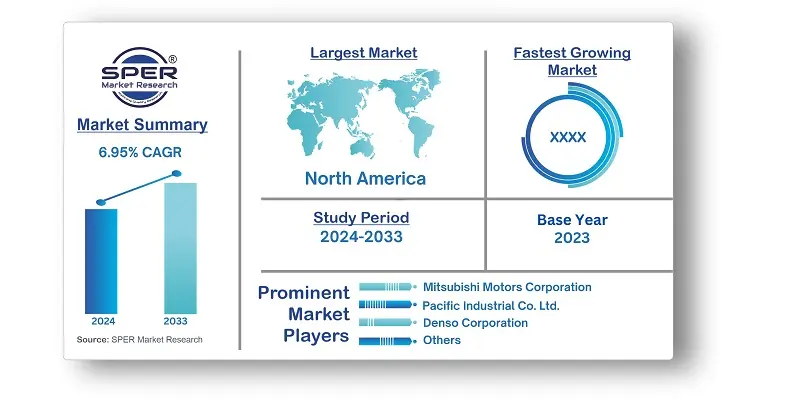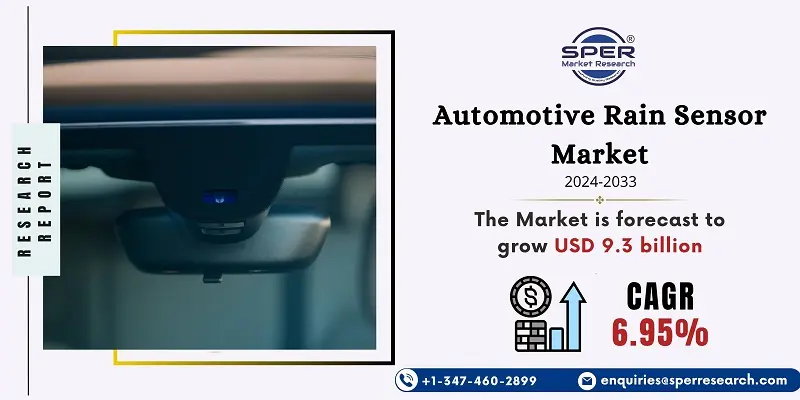
Automotive Rain Sensor Market Growth, Size, Trends, Demand, Share, Revenue and Future Outlook
Automotive Rain Sensor Market Size- By Vehicle Type, By Distribution Channel- Regional Outlook, Competitive Strategies and Segment Forecast to 2033
| Published: Aug-2024 | Report ID: AMIN24183 | Pages: 1 - 228 | Formats*: |
| Category : Automotive & Transportation | |||
- October 2023: Nio and Shanghai Baolong Automotive Corporation, a local auto parts supplier, signed an agreement to co-develop automotive parts. At the current stage, Baolong and Nio will cooperate on products, including air springs, wheel speed sensors, and optical rain sensors.
- July 2023: Valeo, the global automotive technology provider, inaugurated a second line in Sanand, Gujarat, to manufacture Ultrasonic and Rain Sensors. With this additional line, the total annual production capacity will increase from three million to seven million units.
- May 2023: Digitrans started testing all ADAS sensors in artificially reproduced rain at the facility’s new outdoor rain plant, inaugurated in 2022. The analysis was performed as part of the InVade (Integrated Vehicle-in-the-Loop for Automated Driving and E-mobility) joint project by the Institute of Automotive Engineering at the Graz University of Technology.


| Report Metric | Details |
| Market size available for years | 2020-2033 |
| Base year considered | 2023 |
| Forecast period | 2024-2033 |
| Segments covered | By Vehicle Type, By Distribution Channel |
| Regions covered | North America, Asia-Pacific, Latin America, Middle East & Africa and Europe |
| Companies Covered | Denso Corporation, Hamamatsu Photonics KK, HELLA GmbH & Co. KGaA, Mitsubishi Motors Corporation, Pacific Industrial Co. Ltd., Robert Bosch GmbH, TRW Automotive, Vishay Intertechnology, Valeo SA. |
- Raw material suppliers of the materials
- Original Equipment Manufacturers (OEMs)
- Dealers
- Distributors of automotive rain sensors
- Industry Associations
- Private Equity Firms
| By Vehicle Type: |
|
| By Distribution Channel: |
|
- Global Automotive Rain Sensor Market Size (FY’2024-FY’2033)
- Overview of Global Automotive Rain Sensor Market
- Segmentation of Global Automotive Rain Sensor Market by Vehicle Type {Passenger car (PC), Light commercial vehicle (LCV), Heavy commercial vehicle (HCV)}
- Segmentation of Global Automotive Rain Sensor Market by Distribution Channel (OEM, Aftermarket)
- Statistical Snap of Global Automotive Rain Sensor Market
- Expansion Analysis of Global Automotive Rain Sensor Market
- Problems and Obstacles in Global Automotive Rain Sensor Market
- Competitive Landscape in the Global Automotive Rain Sensor Market
- Impact of COVID-19 and Demonetization on Global Automotive Rain Sensor Market
- Details on Current Investment in Global Automotive Rain Sensor Market
- Competitive Analysis of Global Automotive Rain Sensor Market
- Prominent Players in the Global Automotive Rain Sensor Market
- SWOT Analysis of Global Automotive Rain Sensor Market
- Global Automotive Rain Sensor Market Future Outlook and Projections (FY’2024-FY’2033)
- Recommendations from Analyst
1.1. Scope of the report1.2. Market segment analysis
2.1. Research data source
2.1.1. Secondary Data2.1.2. Primary Data2.1.3. SPER’s internal database2.1.4. Premium insight from KOL’s
2.2. Market size estimation
2.2.1. Top-down and Bottom-up approach
2.3. Data triangulation
4.1. Driver, Restraint, Opportunity and Challenges analysis
4.1.1. Drivers4.1.2. Restraints4.1.3. Opportunities4.1.4. Challenges
4.2. COVID-19 Impacts of the Global Automotive Rain Sensor Market.
5.1. SWOT Analysis
5.1.1. Strengths5.1.2. Weaknesses5.1.3. Opportunities5.1.4. Threats
5.2. PESTEL Analysis
5.2.1. Political Landscape5.2.2. Economic Landscape5.2.3. Social Landscape5.2.4. Technological Landscape5.2.5. Environmental Landscape5.2.6. Legal Landscape
5.3. PORTER’s Five Forces
5.3.1. Bargaining power of suppliers5.3.2. Bargaining power of buyers5.3.3. Threat of Substitute5.3.4. Threat of new entrant5.3.5. Competitive rivalry
5.4. Heat Map Analysis
6.1. Global Automotive Rain Sensor Market Manufacturing Base Distribution, Sales Area, Product Type6.2. Mergers & Acquisitions, Partnerships, Product Launch, and Collaboration in Global Automotive Rain Sensor Market
7.1. Global Automotive Rain Sensor Market Size, Share and Forecast, By Vehicle Type, 2020-20267.2. Global Automotive Rain Sensor Market Size, Share and Forecast, By Vehicle Type, 2027-20337.3. Passenger Vehicle7.4. Light Commercial Vehicle7.5. Heavy Commercial Vehicle
8.1. Global Automotive Rain Sensor Market Size, Share and Forecast, By Distribution Channel, 2020-20268.2. Global Automotive Rain Sensor Market Size, Share and Forecast, By Distribution Channel, 2027-20338.3. OEM8.4. Aftermarket
9.1. Global Automotive Rain Sensor Market Size and Market Share
10.1. Global Automotive Rain Sensor Market Size and Market Share By Region (2020-2026)10.2. Global Automotive Rain Sensor Market Size and Market Share By Region (2027-2033)10.3. Asia-Pacific
10.3.1. Australia10.3.2. China10.3.3. India10.3.4. Japan10.3.5. South Korea10.3.6. Rest of Asia-Pacific
10.4. Europe
10.4.1. France10.4.2. Germany10.4.3. Italy10.4.4. Spain10.4.5. United Kingdom10.4.6. Rest of Europe
10.5. Middle East and Africa
10.5.1. Kingdom of Saudi Arabia10.5.2. United Arab Emirates10.5.3. Qatar10.5.4. South Africa10.5.5. Egypt10.5.6. Morocco10.5.7. Nigeria10.5.8. Rest of Middle-East and Africa
10.6. North America
10.6.1. Canada10.6.2. Mexico10.6.3. United States
10.7. Latin America
10.7.1. Argentina10.7.2. Brazil10.7.3. Rest of Latin America
11.1. CASCO
11.1.1. Company details11.1.2. Financial outlook11.1.3. Product summary11.1.4. Recent developments
11.2. DENSO CORPORATION
11.2.1. Company details11.2.2. Financial outlook11.2.3. Product summary11.2.4. Recent developments
11.3. FORD MOTOR COMPANY
11.3.1. Company details11.3.2. Financial outlook11.3.3. Product summary11.3.4. Recent developments
11.4. HAMAMATSU PHOTONIC K.K
11.4.1. Company details11.4.2. Financial outlook11.4.3. Product summary11.4.4. Recent developments
11.5. HELLA GMBH & CO. KGAA
11.5.1. Company details11.5.2. Financial outlook11.5.3. Product summary11.5.4. Recent developments
11.6. KOSTAL AUTOMOBIL ELEKTRIK GMBH & CO. KG
11.6.1. Company details11.6.2. Financial outlook11.6.3. Product summary11.6.4. Recent developments
11.7. MELEXIS
11.7.1. Company details11.7.2. Financial outlook11.7.3. Product summary11.7.4. Recent developments
11.8. VALEO SA
11.8.1. Company details11.8.2. Financial outlook11.8.3. Product summary11.8.4. Recent developments
11.9. VISHAY INTERTECHNOLOGY INC.
11.9.1. Company details11.9.2. Financial outlook11.9.3. Product summary11.9.4. Recent developments
11.10. Others
SPER Market Research’s methodology uses great emphasis on primary research to ensure that the market intelligence insights are up to date, reliable and accurate. Primary interviews are done with players involved in each phase of a supply chain to analyze the market forecasting. The secondary research method is used to help you fully understand how the future markets and the spending patterns look likes.
The report is based on in-depth qualitative and quantitative analysis of the Product Market. The quantitative analysis involves the application of various projection and sampling techniques. The qualitative analysis involves primary interviews, surveys, and vendor briefings. The data gathered as a result of these processes are validated through experts opinion. Our research methodology entails an ideal mixture of primary and secondary initiatives.



Frequently Asked Questions About This Report
PLACE AN ORDER
Year End Discount
Sample Report
Pre-Purchase Inquiry
NEED CUSTOMIZATION?
Request CustomizationCALL OR EMAIL US
100% Secure Payment






Related Reports
Our Global Clients
Our data-driven insights have influenced the strategy of 200+ reputed companies across the globe.




















